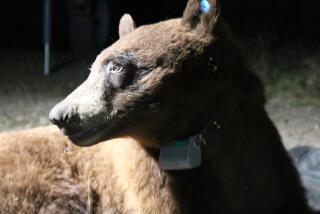Nothing sporting about ‘Hunger Games’ for bears
Bear hunting in California is highly regulated. And that’s good. Don’t forget, this is the state that wiped out its grizzly bears, leaving them only on the California flag. The bear hunting season, which just opened, runs until Dec. 30 and will close early if the quota of 1,700 bears is reached before then. A hunter is allowed only one bear kill per season. No killing of cubs or female bears with them is allowed.
Now awaiting Gov. Jerry Brown’s signature is another piece of regulation, Senate Bill 1221, which will prohibit the use of dogs to hound bears and bobcats. If the governor signs it -- which, hopefully, he will -- California will join 14 other states that similarly ban the hounding of bears. The Times’ editorial page supports the measure.
One of the missions of the state’s Department of Fish and Game is to balance opportunities for hunters with opportunities for observers of wildlife. All the while, the department has to ensure a modicum of animal welfare.
Dogs chasing bears until they are exhausted and terrified and forced up a tree is widely considered cruel, kind of a “Hunger Games” for bears. Is it easier for hunters to find and shoot a bear clinging to a tree while dogs bay at it from the ground? Sure it is. In fact, it’s close to canned hunting -- in which game animals are corralled into a fenced area waiting to be killed -- a practice mostly prohibited in California.
Some argue that treeing the bear lessens the possibility that the animal will be only wounded and not cleanly shot and killed. But experienced hunters pride themselves on having the prowess to track animals and take good aim. If you need dogs to tree your target first, you might want to work on sharpening your skills before heading out into the wilderness. And, in fact, more than half of the bears killed in the state are tracked by hunters without dogs.
Recreational bear hunting in California is never about killing problem bears. Department of Fish and Game officials track the number of bears in the state to manage hunting. It’s not that they’re allowing hunting to manage the population; they decide how many bears can be killed without weakening the population. The state estimates the number of black bears in California at 25,000 to 30,000. But there are questions about how accurate that number really is and where that population is distributed. Just because someone sees a lot of bears in Lake Tahoe doesn’t mean the state is overrun with bears.
As for truly problem bears (as opposed to bears that roam into areas where people have problems keeping their trash secured and food out of their cars), they can be killed by special permit. Depredation permits are issued to people who show compelling evidence of problem bears that have become too habituated to humans or are threatening livestock and other animals. And depredation permit holders do get to use dogs.
Challenging as it can be, we share the wilderness with bears. Hunting them recreationally, whether people approve of it or not, is a sport. But there’s nothing sporting about dogs chasing bears up trees.
ALSO:
Beyond religion in the Middle East
Photos: In South Los Angeles, documenting a building’s evolution
More to Read
A cure for the common opinion
Get thought-provoking perspectives with our weekly newsletter.
You may occasionally receive promotional content from the Los Angeles Times.











